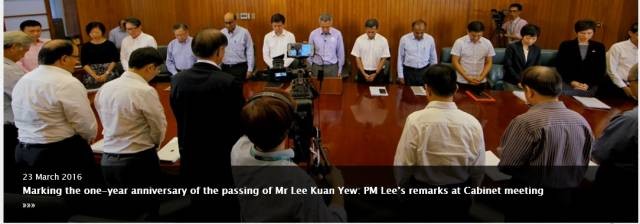今天是紀念李光耀逝世一周年的日子,李顯龍總理下午與內閣成員集體追思建國總理,並發表動情演講。
以下是演講全文。
中文
同事們,
一年前的今天,李光耀先生去世了。之後那一周的全國哀悼已成爲我們建設與發展新加坡認同感的一個裏程碑。
光陰似箭,日月如梭,今天是他逝世後的第一個周年。
我們紀念這一天,是爲了紀念他的一生,並展望未來。遍布新加坡的諸多團體都舉辦各種活動來紀念他的價值和他一生的成就。我們都在重新把自己奉獻給李先生畢生熱愛的新加坡。
在我們開始今天的內閣會議之前,我們先花一來點時間來懷念李先生和他多年來所做出的一切,尤其是在這個房間裏。
人民行動黨在1959年開始執政,原來的總理辦公室是在市政廳。1971年,李先生把他的辦公室搬到了總統府,而這個房間就成爲內閣會議室。40年來,李先生每個星期都在這裏主持或參與內閣會議,討論當天的問題並作出影響新加坡走向的決定。
華語有句話,叫做“運籌帷幄之中,決勝千裏之外”。意思是說,將領坐在軍營裏,爲千裏之外的軍隊策劃戰略和計劃。這個內閣會議室就是李先生的指揮部,是分析和討論問題、作出決定、發出指令和跟蹤進度的地方。
這是一個集體的努力。李先生是團隊的領頭羊,而所有的部長們都積極參與內閣討論。很多人都知道李先生的公衆形象——他的領導風格,他處理問題的方法,以及他的成就。但很少人有像他的內閣同事能夠直接與他共事的榮幸,能夠像我們這裏很多人一樣親身體驗他如何運行他的內閣與政府。那是一個開放、互動和動態的過程,對于所有參與過的人來說,都是一次難忘的經曆。
李先生通常會對討論的問題提出明確的意見。他會敘述曆史,以及爲什麽我們會面臨現在的情形,以便讓我們在做出新的決定時了解來龍去脈。他比較在意的是,如果要拆掉一個籬笆,必須先了解當初爲什麽會修那個籬笆。雖然他經常會直接表達自己的觀點,但也會鼓勵有著不同意見的部長們來爲他們的觀點辯護,並保持開放的態度聽取他們的意見。
令我記憶深刻的一個例子,是我們在1985年削減公積金繳交費的決定。在快速增長的階段,李先生已經非常系統地建立了中央公積金費用,最終把它提升到工資的50%。他以他一貫穩健的方式與主張降低公積金來降低成本的批評者進行辯論。之後,我們遭遇嚴重的經濟衰退。我主持的經濟委員會最終的結論是,費用的確過高,我們確實需要扭轉政策,削減公積金費用來使經濟重新具有競爭力。陳慶炎博士是當時的貿易和工業部長,他也贊同這個觀點。MTI提出了一個內閣文件,提出把公積金繳交率從50%降低至40%。
李先生聽了我們的觀點。令我們驚訝的是,他說如果你們要做就做得幹脆,40%不倫不類的,幹脆直接降低到35%。另外,只削減雇主的費用,不要削減員工的費用,這樣他們收入可以多一些。這是一劑苦藥,我們當時努力說服工會和工人。但它的確有效,讓我們走出了經濟衰退,並迅速創造了工作機會。對于比較年輕的部長們和大衆來說,這是一個重要的經驗。我們不只是在經濟管理方面,而且在政治領導方面都吸取了教訓。
作爲總理,李先生一直對于新加坡的各個方面明察秋毫,無論是我國經濟的健康,我們的外交狀況,還是東海岸公園大道的樹木,以及新加坡河的清潔等等。他沒有對任何事情掉以輕心。
但他知道他不能親自控制一切,而另一位總理將會用不同的方式來管理。他引用毛澤東的話,“十個手指按住十個跳蚤,一個也抓不住”,告訴人們不得不專注于重要的事情,並建立一個團隊。
他本人作出了巨大的努力以確保他的繼任者能夠成功。即使在他辭去總理之職後,他繼續以高級部長以及後來內閣資政的身份參加內閣會議。最引人注目的是,三代更年輕的部長們都從他的經驗、見解、觀點、關切以及他爲新加坡的未來的思考中獲益。因此,近半個世紀以來,在這個房間裏所進行的討論以及所做出的決定在全世界的內閣中都是出類拔萃的。
現在,我們是一個新的團隊,在以新的方式應對一個變化了的世界,但一直被李先生的榜樣和對他的懷念所啓發,也秉持著他代表和支持的堅定的民族精神和價值觀。這將指導我們追逐李先生追逐了一生的彩虹——打造一個優秀傑出的國家,以改善所有新加坡人的生活。
我們有太多需要感謝他的地方,現在我請大家起立,共同默哀一分鍾。
(譯文由風鈴提供)
英文
Colleagues,
One year ago today, Mr Lee Kuan Yew passed away. The week of national mourning that followed was a landmark in our nation building, and in developing a Singapore identity.
Time passes quickly, and now we are at the first anniversary.
We are marking this day by celebrating Mr Lee’s life and looking forward. Many groups all over Singapore are holding events to commemorate his values and his life work. We are all rededicating ourselves to Mr Lee’s lifelong passion – Singapore.
As we begin our Cabinet meeting today, let us take a moment to remember Mr Lee and what he stood for and did over the years, especially in this very room.
The PAP came into power in 1959. At first, the Prime Minister’s Office was at the City Hall. In 1971, Mr Lee moved his office to the Istana. Cabinet meetings were held in this room. Every week for 40 years, Mr Lee chaired or attended Cabinet here to discuss the issues of the day, and make decisions that set the course for Singapore.
There is a Chinese saying “運籌帷幄之中,決勝千裏之外”. The general sits in his command tent, devising strategies and plans that bring his armies victory a thousand miles away in the field. This Cabinet Room was Mr Lee’s command tent, where issues were examined and debated, decisions were taken, instructions given, and progress tracked.
This was a collective endeavour. Mr Lee was primus inter pares – first among equals. But the Ministers took active part in Cabinet deliberations. Many know Mr Lee’s public face – his leadership style, his approach to problems, his record of achievements. But few have had the privilege of his Cabinet colleagues, including quite a number of us here today, who worked directly with him, and experienced up close how he ran his Cabinet and Government. It was an open, interactive, dynamic process, an unforgettable experience for all those who participated in it.
Mr Lee would usually have clear views on the matter under discussion. He would recount the history and the considerations that led us to where we were, so that we kept sight of the context as we made fresh decisions. He was mindful that before removing the fence, one had to understand why it had been put there in the first place. Though he often gave his views up front, he would encourage Ministers with different views to argue their case, and listen to them with an open mind.
One example I remember well was our decision to cut CPF contributions in 1985. During a phase of rapid growth, Mr Lee had systematically built up CPF contributions, eventually raising them to 50% of wages. He had defended this in his usual robust way, against critics who wanted to reduce the CPF to cut costs. Then we ran into a severe recession. I chaired the Economic Committee, which eventually concluded that costs had got out of line, and that we did indeed need to reverse policy, to cut the CPF to make the economy competitive again. Dr Tony Tan was the Minister for Trade and Industry, and he agreed. MTI put up a Cabinet paper proposing to cut the CPF contribution rate from 50% to 40%.
Mr Lee listened to our arguments. Then to our surprise he said if you are going to do it, do it properly. 40% is neither here nor there. Make a decisive move, and cut it to 35%. Furthermore, cut only the employer’s contributions. Do not cut employees’ contributions to increase take home pay. That may sweeten the package, but it will do nothing to make us more competitive. It was bitter medicine, and we had to work hard to sell it to the unions and workers. But it worked, brought us out of the recession and brought jobs back quickly. It also was an important bonding exercise and experience for the younger ministers and the population. We learnt a lesson not just in economic management but in political leadership.
As Prime Minister, Mr Lee kept an eagle’s eye on every aspect of Singapore, whether it was the health of our economy, the state of our foreign relations, the trees along the East Coast Parkway, or the cleanliness of the Singapore River. He left nothing to chance.
And yet he knew that he could not control everything personally, and that even more so another Prime Minister would have to govern in a different way. He advised us that one could not use ten fingers to catch ten fleas, quoting Mao. One had to focus on the important things and build a team.
He himself made an enormous effort to ensure that his successors succeeded. Even after he stepped down as Prime Minister, he continued to attend Cabinet meetings as Senior Minister and later as Minister Mentor. Most remarkably, three generations of younger ministers benefitted from his experience and insights, his views and concerns, and increasingly his thoughts for Singapore’s future. So for nearly half a century, here in this room, we had a level of discussion and decision-making that would have been exceptional in any Cabinet room in the world.
Now we are a new team, dealing with a changed world in new ways, but always inspired by Mr Lee’s example and his memory, and holding firm the ethos and values that he stood and fought for. These will guide us as we in our turn follow the rainbow that Mr Lee himself chased all his life – to build an exceptional nation and to improve the lives of all Singaporeans.
We have so much to be grateful for. Now I invite you to rise, and observe a minute of silence together.

